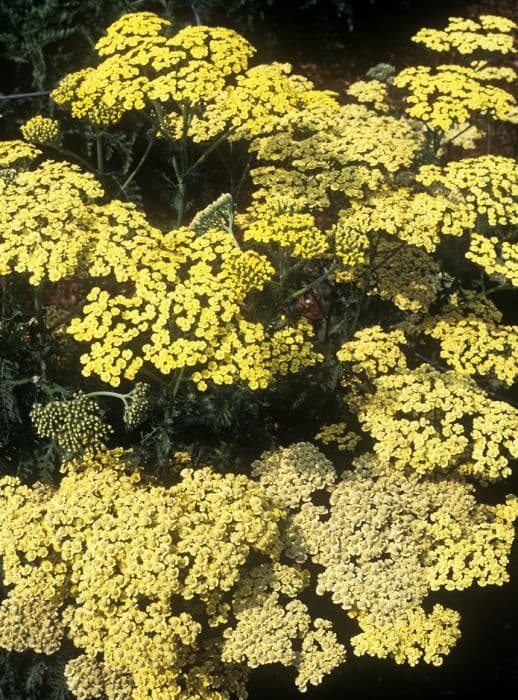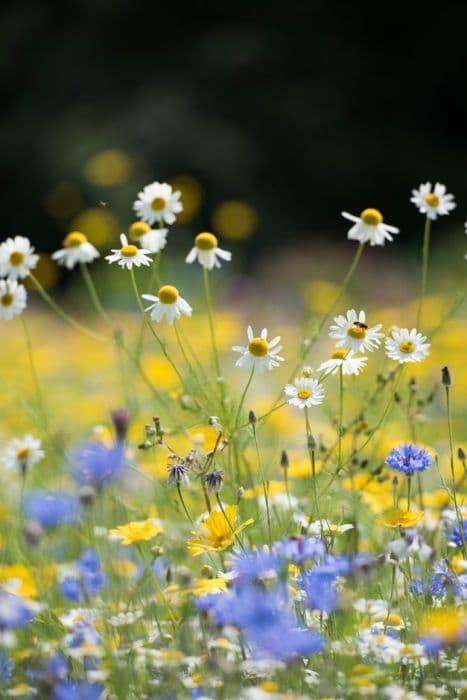Chrysanthemum Chrysanthemum 'Dark Red Mayford Perfection' (4b)

ABOUT
Chrysanthemum 'Dark Red Mayford Perfection,' commonly known as mums or chrysanthemums, features a lush display of deeply colored, dark red flowers. The blooms are quite showy, with a multitude of layered petals that curl and overlap, creating a dense, pompom-like effect. The rich red hue of the blossoms is reminiscent of a fine wine or dark velvet, exuding a sense of warmth and depth. The leaves of the plant are a deep green, which contrasts strikingly with the dark red flowers, emphasizing their color intensity. These leaves are typically lance-shaped and may have a slightly serrated edge, providing an attractive textured backdrop for the large and vivid blooms. Chrysanthemums in general have a bushy habit, leading to a plentiful floral display that can cover the plant. The 'Dark Red Mayford Perfection' variety carries its bold flowers on sturdy stems, which stand out amid the green foliage. Together, the combination of its sumptuous, dark red flowers and rich green leaves makes the Chrysanthemum 'Dark Red Mayford Perfection' a striking addition to any garden, delivering a pop of dramatic color and a classic aesthetic that is often associated with the autumn season.
About this plant
 Names
NamesSynonyms
Mum, Chrysanthemum, Hardy Chrysanthemum, Garden Mum.
Common names
Chrysanthemum 'Dark Red Mayford Perfection'
 Toxicity
ToxicityTo humans
The plant commonly known as Chrysanthemum is generally considered to have low toxicity for humans. However, it can cause dermatitis in some sensitive individuals following skin contact with the leaves or flowers. If ingested, it might cause mild gastrointestinal upset, including nausea, vomiting, and diarrhea. Ingesting significant quantities may lead to more severe reactions, but such cases are uncommon.
To pets
Chrysanthemums are toxic to pets, particularly cats and dogs. Symptoms of poisoning in pets can include drooling, vomiting, diarrhea, incoordination, and dermatitis. In more severe cases, ingestion can lead to signs of toxicity affecting the nervous system. If you suspect your pet has ingested Chrysanthemum, you should contact your veterinarian immediately.
 Characteristics
CharacteristicsLife cycle
Perennials
Foliage type
Deciduous
Color of leaves
Green
Flower color
Dark red
Height
2 feet (0.61 meters)
Spread
2 feet (0.61 meters)
Plant type
Herb
Hardiness zones
5
Native area
Asia
Benefits
 General Benefits
General Benefits- Aesthetic Appeal: Adds vibrant dark red color and decorative pompom-like flower heads to gardens.
- Long Blooming: Offers an extended blooming period, typically from late summer to fall, providing sustained garden interest.
- Versatility: Can be used in a variety of garden settings, including borders, container plantings, and as cut flowers for arrangements.
- Attracts Pollinators: The flowers attract bees and butterflies, promoting pollination in the garden.
- Drought Tolerance: Once established, these plants can tolerate periods of drought, making them suitable for xeriscaping.
- Cold Hardy: Can survive and thrive in USDA hardiness zone 4b, demonstrating good cold tolerance.
- Low Maintenance: Requires minimal care once established, making it a convenient choice for gardeners of all skill levels.
 Medical Properties
Medical PropertiesThis plant is not used for medical purposes.
 Air-purifying Qualities
Air-purifying QualitiesThis plant is not specifically known for air purifying qualities.
 Other Uses
Other Uses- Natural fabric dye: The flowers of the Chrysanthemum can be used to create a natural dye for fabrics, providing a range of colors from golden to reddish hues, adding a unique touch to textile crafts.
- Culinary decoration: Petals from Chrysanthemum flowers can be used to decorate cakes and pastries, introducing an edible and aesthetic floral element to desserts.
- Photography subject: The vivid color and intricate form of these flowers make them an excellent subject for photography enthusiasts seeking to capture the beauty of nature.
- Art inspiration: Artists can use the Chrysanthemum as inspiration for paintings, drawings, and textiles designs due to its deep red color and layered petal structure.
- Companion planting: Gardeners may plant Chrysanthemums near vegetable gardens as they can help deter certain pests, thus acting as a natural form of pest control.
- Garden design: With their striking dark red blooms, these Chrysanthemums can be used to create a dramatic contrast in garden designs, especially in autumn floral arrangements.
- Fragrance extraction: While not commonly known for their scent, some Chrysanthemum varieties can be used in the production of subtle perfumes and fragrances.
- Book pressing: The flowers of Chrysanthemum can be pressed and used in the art of book pressing, creating elegant bookmarks or embellishments for handmade books.
- Crafting potpourri: Dried Chrysanthemum petals can be added to potpourri mixes for decorative purposes, contributing to the visual appeal of the mixture.
- Special occasions: In some cultures, Chrysanthemums are used in festival decorations or given as gifts during certain celebrations due to their significant cultural symbolism.
Interesting Facts
 Feng Shui
Feng ShuiThe Chrysanthemum is often used in Feng Shui to promote happiness and joy. Its vibrant red color is associated with passion and energy, making it an excellent choice for an area of your home where you want to introduce vibrancy and positivity. You can place red Chrysanthemums in the living room to enhance social gatherings and create a welcoming atmosphere.
 Zodiac Sign Compitability
Zodiac Sign CompitabilityThe Chrysanthemum is not used in astrology practice.
 Plant Symbolism
Plant Symbolism- Longevity: Chrysanthemums are often associated with long life and endurance due to their hardiness and the longevity of their blooms.
- Loyalty and Devotion: The flower’s ability to bloom in the fall, a time when most other flowers have faded, represents fidelity and devotion that persists despite adversity.
- Death: In some European cultures, chrysanthemums are symbolic of death and are used for funerals or to honor the lives of the deceased.
- Rebirth: Similarly, because they bloom in the fall, chrysanthemums symbolize the cycle of life, death, and rebirth.
- Nobility: In Asian cultures, the chrysanthemum is a noble flower, often associated with royalty and the upper classes.
- Optimism and Joy: The bright and cheery appearance of the flower lends itself to symbolizing happiness and positivity.
- Perfection: The orderly unfolding of the chrysanthemum's petals represents perfection and, in some interpretations, the ideal way of unfolding one’s life.
 Water
WaterMums require even moisture and should be watered regularly, but be careful not to overwater. Water your Chrysanthemum 'Dark Red Mayford Perfection' thoroughly when the top inch of soil feels dry to the touch. Depending on the weather and soil conditions, this could be about once a week, but always check the soil moisture first. Apply water slowly to the base of the plant until it begins to run through the drainage holes, which could be roughly around 1 gallon for an outdoor plant of average size. During hot spells or if you have sandy soil that drains quickly, you might need to water more frequently.
 Light
LightMums thrive in full sunlight, so place your Chrysanthemum 'Dark Red Mayford Perfection' in a spot where it can receive at least 6 hours of direct sunlight per day. A south-facing location is ideal for maximum exposure to natural light. Avoid shaded areas as insufficient light can lead to weak stems and fewer blooms.
 Temperature
TemperatureMums prefer cooler conditions and will thrive in temperatures between 60°F and 70°F. The Chrysanthemum 'Dark Red Mayford Perfection' can tolerate a light frost, but temperatures below 32°F may damage the plant. It's best to protect them from extreme heat above 90°F, which can stress the plant and affect flowering.
 Pruning
PruningPrune Mums to encourage bushier growth and more blooms. Pinch back the Chrysanthemum 'Dark Red Mayford Perfection' by removing the top inch of each stem when they are about 6 inches tall; repeat this process every 2 to 3 weeks until mid-July. The best time to prune is early in the growing season before the plant sets buds.
 Cleaning
CleaningAs needed
 Soil
SoilChrysanthemums thrive in well-draining soil that is rich in organic matter. Mix equal parts of garden soil, peat moss, and perlite to create an ideal growing medium. A soil pH between 6.0 and 7.0 is optimal for mums.
 Repotting
RepottingMum plants generally need to be repotted every 1-2 years or when they outgrow their current pot. This will provide fresh nutrients and room for growth.
 Humidity & Misting
Humidity & MistingMums prefer moderate to high humidity levels, but they can tolerate lower humidity if the soil moisture is maintained.
 Suitable locations
Suitable locationsIndoor
Ensure bright light, proper watering, and good air circulation.
Outdoor
Full sun, well-drained soil, pinch for bushiness.
Hardiness zone
5-9 USDA
 Life cycle
Life cycleThe life of the Chrysanthemum 'Dark Red Mayford Perfection' begins with seed germination, which occurs in a warm environment with adequate moisture. Following germination, the seedling emerges and develops into a young plant with a set of true leaves, marking the vegetative growth stage. During this time, the plant undergoes substantial growth, producing stems, leaves, and a robust root system in preparation for blooming. The next phase is the flowering stage, where the plant produces its distinctive dark red blooms, typically in late summer or fall depending on the climate. After the flowering period, chrysanthemums enter a period of senescence, where leaves may yellow and die back as the plant prepares for dormancy. Finally, in regions with cold winters (4b), the plant becomes dormant to survive adverse conditions, completing its annual cycle with the return of favorable growth conditions in spring.
 Propogation
PropogationPropogation time
Spring-Summer
Propogation: Chrysanthemum 'Dark Red Mayford Perfection', commonly known as hardy garden mum, is often propagated through division, which is the most popular method for this particular plant. To propagate by division, the process is generally performed in the spring just as the new growth begins to appear. Gardeners will dig up the entire plant, being careful to keep as much of the root system intact as possible. After gently shaking off excess soil, the clump can be separated into smaller sections, each with several shoots and a portion of the root system. These sections are then planted in well-draining soil, spaced about 18 to 24 inches (approximately 45 to 60 centimeters) apart to allow for growth and air circulation. Watering thoroughly after planting helps establish the divisions. With proper care, these will grow into full plants and can be expected to bloom in the following season.









